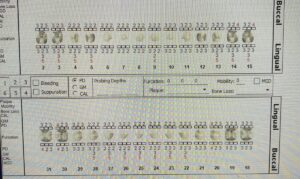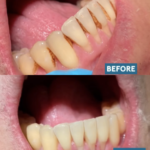The patient under examination was a 42-year-old Asian male who presented to our clinic seeking dental care. He had not sought dental treatment for over five years. Upon reviewing their medical history, he presents with a blood pressure of 119/76 with a pulse of 77 which corresponds to a normal blood pressure. He has history of allergies to seafood and nickel but it is not a contraindication towards dental treatment. Overall, he is not taking any medications, non-smoker and no systemic diseases. Upon further review of his medical history he stated having experienced a minor psychotic episode approximately seven years ago but he did not want to elaborate further regarding the event. Reflecting on this information, I suspected that the past episode might have contributed to his noncompliance with regular dental check-ups and cleanings; so I asked him why has it been so long since he has been seen by a dentist and he stated that he just couldn’t get around good dental insurance.
During the comprehensive examination, he stated that his oral regimen at home consisted of brushing twice a day with an oral-b electric toothbrush; along with flossing once a day. Moving on to further oral assessments, I observed that the patient presented with generalized inflamed gingiva, rolled margins, and severe black staining. Periodontal evaluation which consists of measuring the depths of the gums, revealed generalized 1-3 mm probing depths with localized areas of 4 mm probing depths, accompanied by moderate to severe bleeding upon probing. Based on the oral assessments, the patient fell into the heavy stage II grade B classification.
Recognizing the importance of assisting the patient in improving their oral health habits and overall regimen. Their plaque index score was 1.8 ( which equates to poor oral hygiene). I began by teaching them the sulcular tooth brushing technique which focuses on the area of the teeth he might’ve missed while brushing. I emphasized the significance of flossing and brushing twice a day along with the implementation of using an antiseptic oral rinse to help reduce oral bacteria; since he mentioned he does not use any. As our conversation progressed, the patient ended up mentioning their daily consumption of coffee and tea, which could be the cause of their severe brown staining. With the information I was able to gather, I provided him with nutritional information and positive reinforcement regarding oral habits. I noticed their interest and engagement which assured me as a clinician.
Given the time available, I was not able to expose this patient to any radiographs since he wanted me to complete his cleaning within the one visit. I emphasized that although he didn’t have any suspicious cavities that it is imperative to have them done at his next visit to maintain upkeep of his periodontal health and to catch any suspicious cavities. I assured the patient that I would be able to complete their cleaning on the same day. Throughout the process, I prioritized their comfort and satisfaction, ensuring a thorough prophylaxis treatment. By the end of the appointment, the patient expressed how thankful they were with the comprehensive care I provided, appreciating the manner in which I approached their treatment. I instructed him to be seen for general dental cleanings every three months along with x-rays since it has been a while in order to maintain his oral hygiene.




